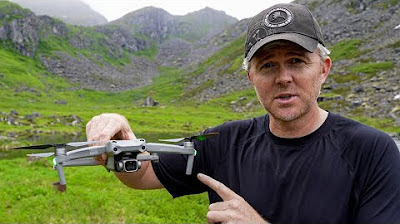MODUL 03 (SEK. MENENGAH) - PRINSIP PENERBANGAN DRON
Summary
TLDRThis instructional video script delves into the fundamental principles of drone flight, emphasizing the importance of understanding the six degrees of freedom for effective drone control. It explains the basic movements including forward/backward, left/right, up/down, and rotational maneuvers. The script also covers the use of a radio-controlled transmitter to manage these movements, illustrating how the drone's propellers work in tandem to achieve lift, directional movement, and stability. It concludes by highlighting the complexity of physical laws, such as Bernoulli's principle and Newton's laws, that govern drone flight.
Takeaways
- 😀 The module discusses the basic principles of drone flight, emphasizing the importance of understanding drone movement for proper control.
- 🔄 It introduces the concept of 'six degrees of freedom' which are the six independent directions of movement a drone can make in three-dimensional space.
- 🕊️ The first movement is 'forward and backward' motion, controlled by the action of the drone propellers and demonstrated with an example.
- 🚀 The second movement is 'lateral' or 'roll' movement, allowing the drone to move left and right, which is crucial for maneuverability.
- 📍 The third movement is 'vertical' or 'pitch' movement, enabling the drone to move up and down, a fundamental aspect of flight control.
- 🌀 The fourth movement is 'yaw', where the drone can rotate on its axis, left and right, affecting its orientation.
- 🎢 The fifth movement is 'tilt' or 'roll', which involves the drone banking to one side, integral for turning maneuvers.
- 🔄 The final movement is 'combined' movements, where the drone can perform complex maneuvers by combining the basic movements.
- 📡 Radio-controlled devices are used to control drone movements, with two main control sticks responsible for different aspects of flight.
- 🛫 The direction and speed of propeller rotation are critical for drone lift, stability, and directional control.
- ⚙️ Understanding the physics behind drone flight, such as Bernoulli's principle and Newton's laws, is essential for advanced flight control and maneuvering.
Q & A
What is the main topic of the video script?
-The main topic of the video script is the basic principles of drone flight, including the six degrees of freedom (6DOF) and how to control these movements for proper drone operation.
What are the six degrees of freedom referred to in the script?
-The six degrees of freedom are the six independent directions of movement in three-dimensional space: surge (forward and backward), sway (side to side), heave (up and down), roll (tilting left and right), pitch (nose up and down), and yaw (turning left and right).
What is the term 'roll' in the context of drone movements?
-In the context of drone movements, 'roll' refers to the rotation of the drone around its longitudinal axis, causing it to tilt to the left or right.
How does the script describe the drone's forward and backward movement?
-The script describes the drone's forward and backward movement as 'surge', which is the first type of movement involving straight-line motion in the direction of the drone's length.
What is the term 'pitch' in drone movement, and how is it controlled?
-The term 'pitch' refers to the nose-up and nose-down movement of a drone. It is controlled by the rotation speed of the propellers, with the rear propellers rotating faster than the front propellers to cause the drone to pitch down and move forward.
What does the script mean by 'radio-controlled' in the context of drone operation?
-In the context of drone operation, 'radio-controlled' refers to the method of controlling the drone's movements using a remote control device that sends signals to the drone, allowing the operator to manage its flight path and actions.
How are the drone's yaw movements described in the script?
-The script describes the drone's yaw movements as 'yoyo' or 'yaw' in English, which involves the drone turning left or right. This movement is achieved by varying the rotation speed of the propellers on the left and right sides of the drone.
What is the purpose of the propellers' rotation direction in a drone?
-The rotation direction of the propellers is crucial for creating the lift and thrust needed for the drone to ascend, descend, and move in different directions. Proper coordination of the propellers' rotation direction and speed is essential for stable drone flight.
How does the script explain the relationship between the propellers' rotation speed and the drone's lift?
-The script explains that when all four propellers rotate at the same speed, the drone can ascend or hover in the air. The lift is generated by the downward thrust of the propellers, which counteracts the drone's weight.
What is the term 'Bernoulli's principle' mentioned in the script, and how does it relate to drone flight?
-Bernoulli's principle is a fundamental concept in fluid dynamics that relates the speed of a fluid to its pressure. In the context of drone flight, it helps explain how the airflow over and under the propellers creates the lift that allows the drone to ascend and hover.
What are the 'Newton's laws' referred to in the script, and how do they apply to drone movements?
-Newton's laws of motion describe the relationship between the motion of an object and the forces acting upon it. In the context of drone movements, these laws help explain how the drone responds to the forces generated by the propellers' rotation, affecting its acceleration, deceleration, and directional changes.
Outlines

This section is available to paid users only. Please upgrade to access this part.
Upgrade NowMindmap

This section is available to paid users only. Please upgrade to access this part.
Upgrade NowKeywords

This section is available to paid users only. Please upgrade to access this part.
Upgrade NowHighlights

This section is available to paid users only. Please upgrade to access this part.
Upgrade NowTranscripts

This section is available to paid users only. Please upgrade to access this part.
Upgrade NowBrowse More Related Video
5.0 / 5 (0 votes)





